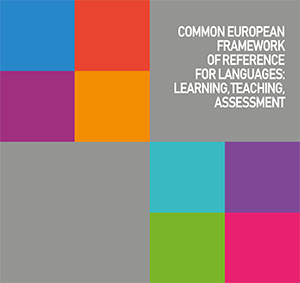Purposes of the CEFR

It describes in a comprehensive way what language learners have to learn to do in order to use a language for communication and what knowledge and skills they have to develop so as to be able to act effectively. The description also covers the cultural context in which language is set. The Framework also defines levels of proficiency which allow learners' progress to be measured at each stage of learning and on a life-long basis.
Main objectives of the CEFR:
⇒ promoting plurilingualism and diversification in the choice of languages in the curriculum
⇒ supporting the development and demonstration of the plurilingual profile of individual learners
⇒ developing and reviewing the content of language curricula and defining positive ‘can do’ descriptors adapted to the age, interests and needs of learners
⇒ designing and developing textbooks and teaching material
⇒ supporting teacher education and cooperation among teachers of different languages
⇒ enhancing quality and success in learning, teaching and assessment
⇒ facilitating transparency in testing and the comparability of certifications
 A starting point for reflection and exchanges
A starting point for reflection and exchanges
The CEFR is intended to provide a shared basis for reflection and communication among the different partners in the field, including those involved in teacher education and in the elaboration of language syllabuses, curriculum guidelines, textbooks, examinations, etc., across the member states of the Council of Europe. It is offered to users as a descriptive tool that allows them to reflect on their decisions and practice, and to situate and co-ordinate their efforts, as appropriate, for the benefit of language learners in their specific contexts.
The CEFR is therefore a flexible tool to be adapted to the specific context of use – a fundamental aspect fully reflected in the level system which can be adapted and exploited flexibly for the development of learning /teaching objectives and for assessment. This flexibility may be seen in the development of Reference Level Descriptions (RLDs) for particular languages and contexts.
 The CEFR has been written with two main aims in mind:
The CEFR has been written with two main aims in mind:
- to encourage practitioners of all kinds in the language field, including language learners themselves, to reflect on questions such as those suggested in the Notes for the user (CEFR, p. xii) regarding the analysis of learning/teaching situations.
- to make it easier for practitioners to explain to each other and to their clientèle what they wish learners to achieve, and how they may do so.
One thing should be made clear: the CEFR does not set out to tell practitioners what to do, or how to do it. It raises questions but doesn’t provide ready-made anwers. It is not the function of the Common European Framework of Reference to lay down the objectives that users should pursue or the methods they should employ.
This does not mean that the Council of Europe is indifferent to these issues. Indeed, a number of specialists who have contributed to language policy projects have put a great deal of thought and work into the principles and practice of language learning, teaching and assessment over the years.
A survey was carried out among Council of Europe member states on the use of the CEFR in teacher education, the reform of foreign language curricula and the development of teaching materials: Results of a survey
The issue of responsibilities for appropriate use of the CEFR was discussed during a major intergovernmental Forum in 2007 (see section Responsabilities of member states).
 Relation between the CEFR and the ELP
Relation between the CEFR and the ELP
The CEFR and the European Language Portfolio (ELP) were developed in parallel.The ELP is an instrument based on the CEFR with which individual learners can reflect upon their learning and record their progress.
More about the relation between the CEFR and the ELP
Using the CEFR in specific contexts
The CEFR does not offer ready-made solutions but must always be adapted to the requirements of particular contexts, for example, the teaching and learning of Romani, or of signed languages (see the ECML ProSign project).
There is a particular need for careful interpretation and adaptation when the CEFR’s descriptive scheme and proficiency levels are for example used to explore the communicative needs of adult migrants and to guide the assessment of their proficiency in the language of their host community.
The CEFR is non-language specific however this instrument is essential for the definition of learning/teaching objectives for specifc languages.
Section Reference level descriptions.



